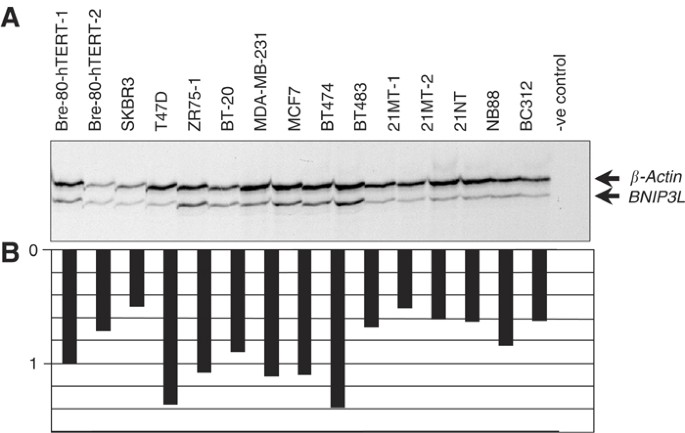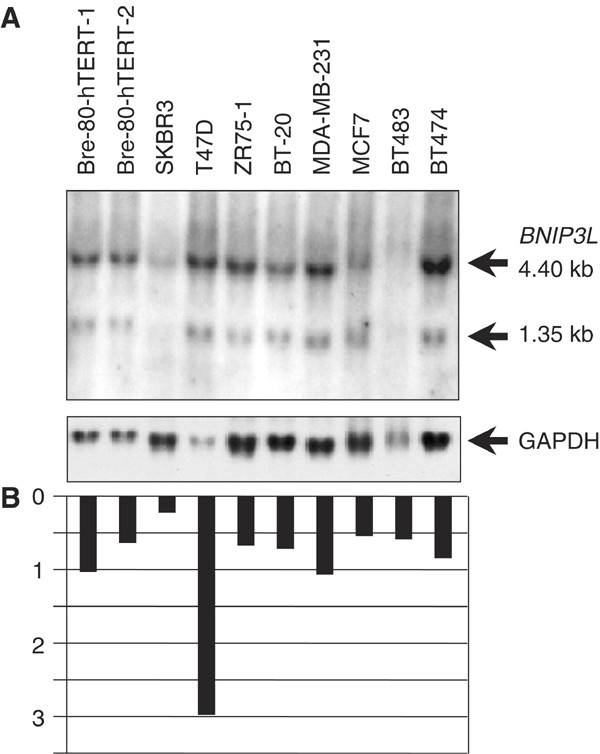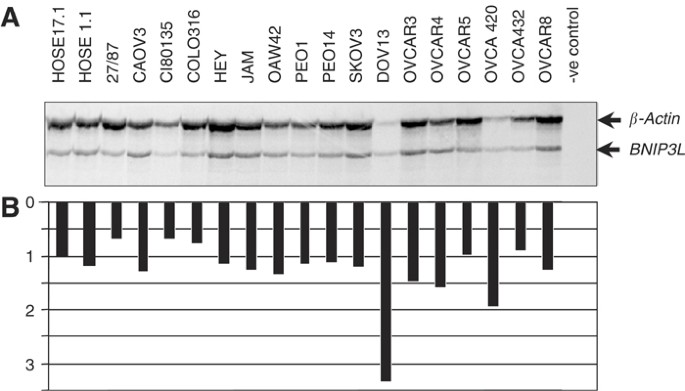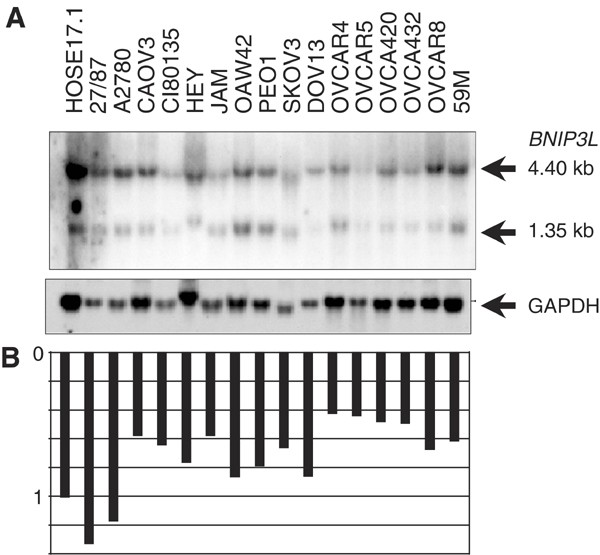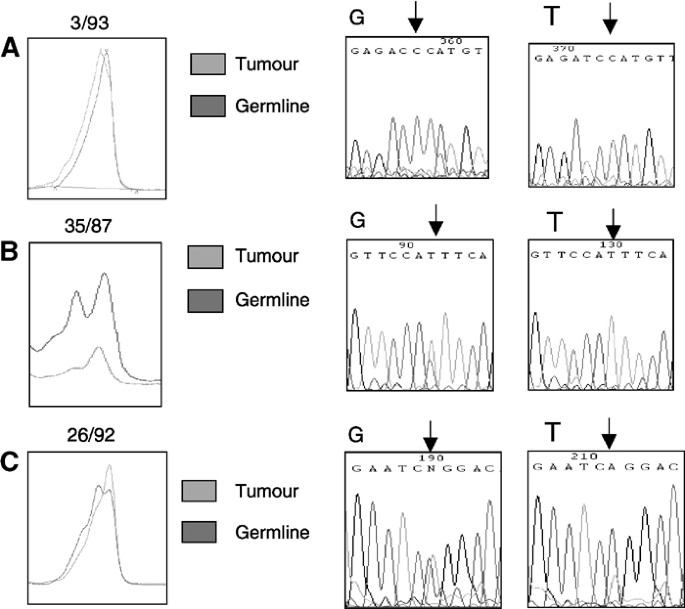Analysis of the candidate 8p21 tumour suppressor, BNIP3L, in breast and ovarian cancer (original) (raw)
Main
Breast and ovarian cancers are the leading and fifth leading causes of cancer deaths, respectively, in women in developed countries. Both cancers are epithelial in origin and share some common genetic and epidemiological risk factors (Claus et al, 1996). While some of the genes involved in predisposition to familial breast and ovarian cancer are known (Claus et al, 1996; Welsch and King, 2001), little is understood about the somatic molecular changes that occur during the development of sporadic breast and ovarian cancer. Few genes have been found to be frequently down-regulated in these tumours, and even fewer to carry frequent mutations (Liu and Ganesan, 2002).
The highest rates of loss of heterozygosity (LOH) in breast cancer are found at 17p, 8p and 7q, while in ovarian cancer they are at 17p, 17q, 8p, 22q and 18q (Callahan et al, 1992; Shelling et al, 1995; Phelan et al, 1998; Seitz et al, 2000; Pribill et al, 2001). LOH has been reported at 8p12–8p23 in over 50% of primary breast tumours (Wang et al, 1999; Yokota et al, 1999). Similarly, LOH occurs in over 50% of ovarian tumors at p12–p23 (Brown et al, 1999; Wright et al, 1998). The occurrence of this common region of LOH in breast and ovarian cancer suggests that 8p12–23 probably harbours one or more tumour suppressor genes that are somati-cally inactivated in these neoplasms.
The BNIP3L gene is located between markers D8S1752 and D8S1989 that map to 8p21 in the smallest region of overlap (SRO) identified by LOH analysis of breast and ovarian tumours (Seitz et al, 2000; Brown et al, 1999), and to a region of prostate cancer metastasis suppression (Nihei et al,, 1996). BNIP3L encodes a protein that is homologous to the proapoptotic protein BNIP3 (Matsushima et al, 1998; Chen et al, 1999; Imazu et al, 1999; Yasuda et al, 1999). Several well-characterised tumour suppressor genes such as PTEN, p53 and RB have been shown to function through the control of apoptosis (Bellamy, 1997; Zornig et al, 2001), making BNIP3L a good candidate for an 8p tumour suppressor gene. Like its homologue, BNIP3L contains a sequence motif for a transmembrane domain and a putative proapoptotic BH3 (Bcl-2 homology-3) domain (Yasuda et al, 1999). BNIP3L interacts with the antiapoptotic viral proteins E1B19kD and BCL2 to induce cell death by altering mitochondrial membrane permeability (Chen et al, 1999; Imazu et al, 1999; Yasuda et al, 1999). Further evidence for a possible tumour suppressor role of the BNIP3L gene is provided by experiments showing that the clonicity in soft agar of cervical cancer cell lines was suppressed after transfection of the BNIP3L gene (Matsushima et al, 1998). Considering its function and location, BNIP3L is a strong candidate for the breast and/or ovarian cancer tumour suppressor gene located at 8p21.
In order to determine whether BNIP3L functions as a tumour suppressor gene in breast and/or ovarian cancer, we have analysed its expression in ovarian and breast cancer cell lines and screened all exons for mutations in a panel of primary ovarian and breast cancers.
Materials and methods
Cell lines
Human ovarian surface epithelial cell lines (HOSE) 1.1 and 17.1, immortalised with a retroviral vector expressing human papillomavirus oncogenes (Tsao et al, 1995), were cultured in RPMI 1640 with 10% FCS. The human ovarian cancer cell lines 27 27/87, A2780, CAOV3, CI8O135, COLO316, JAM, OAW 42, PEO1, PEO14, SKOV3 and OVCAR 3 were maintained in RPMI 1640 with 10% FCS, and HEY, DOV-13, OVCA 432, OVCAR-4, OVCAR-5 and OVCAR-8 were maintained in MEM alpha with 10% FCS. OVCA 420 was maintained in 1 : 1 MCDB105 : M199 with 10% FCS and 59M was maintained in DMEM with 10% FCS.
The human breast epithelial cell lines Bre-80-hTERT1 and Bre-80-hTERT2 (gifts of R Reddel), immortalised with human telomerase cDNA, were cultured in 1 : 1 RPMI 1640 : MCDB 170 with 10% FCS, and MCDB 170 with 10% FCS respectively. The human breast cancer cell lines BC 312, NB88, T-47D, ZR-75-1, BT-20, MDA-MB-231, BT474 and BT483 were maintained in RPMI 1640 with 10% FCS with the latter two supplemented with 1 _μ_g ml−1 insulin. The cell lines 21MT-1, 21MT-2 and 21NT were maintained in MEM alpha with 10% FCS, 10 mM HEPES, 1 _μ_g ml−1 insulin, 2.8 μ M hydrocortisone and 0.1 mM nonessential amino acids. SK-BR-3 was maintained in DMEM with 10% FCS and MCF7 was maintained in MEM alpha with 10% FCS and 1 _μ_g ml−1 insulin.
Primary tumours
Primary ovarian tumour cells were obtained from 40 patients with malignant ovarian neoplasms undergoing surgery (Table 2). There were 31 serous tumours, seven endometrioid tumours and two clear cell tumours. All patients were staged at laparotomy, in accordance with the recommendations of the International Federation of Gynaecology and Obstetrics (FIGO). Primary breast tumours were obtained from 25 patients with malignant tumours undergoing surgery ( Table 3). All patients were staged at surgery, in accordance with the recommendations of the American Joint Committee on Cancer (AJCC) and Union Internationale Contre le Cancer (UICC). The corresponding constitutional DNA was available in all cases from peripheral blood. Informed consent was obtained from all patients.
Table 2 LOH status, mutation results and clinicopathological features of primary ovarian tumours
Table 3 LOH status, mutation results and clinicopathological features of primary breast tumours
DNA and RNA isolation
Cell lines were harvested for DNA and RNA extraction at about 80% confluence. Total RNA was extracted from breast and ovarian cell lines using the Tri-reagent (Sigma Castle Hill, New South Wales, Australia) following the manufacturer's instructions. PolyA+ RNA was prepared from total RNA using Dynabeads mRNA purification kit (Dynal, Carlton South, Victoria, Australia). For the primary ovarian tumours, tumour tissue was dissected free from necrotic and connective tissue and mechanically dispersed prior to collagenase treatment (0.1 mg ml−1 in Hanks balanced salt solution). Dead and red cells were then removed by Ficoll–Paque, and genomic DNA was extracted by the salting-out method (Miller et al, 1988). The purity of the resulting DNA is supported by the high frequency of LOH on chromosome 17 detected in ovarian tumour DNA prepared by this method (Leary et al, 1995). DNA was also extracted from peripheral blood and cell lines using the salting-out method. For breast tumours, DNA was extracted from snap-frozen pieces (containing at least 70% tumour cells) by proteinase K digestion, followed by phenol/chloroform extraction.
Semiquantitative RT--PCR and Northern blot analysis
cDNA synthesis was primed with random hexamers and carried out on 1 _μ_g of total RNA using Superscript II (Promega). Primers pairs were designed to span at least one intron to avoid contamination from genomic DNA. RT–PCR was performed using 1 _μ_l cDNA incorporating 33P-dATP in a total volume of 20 _μ_l. Reactions were multiplexed with primers for β-actin, which served as an internal control. All primer sequences are listed in Table 1. Products were taken out at the end of cycles 20, 25 and 30 in order to assess amplification in the exponential phase, and these products were then run on a 5% denaturing acrylamide gel prior to autoradiography.
Table 1 Primers used in the analysis of the BNIP3L gene
RNA was denatured and electrophoresed on a formaldehyde-agarose gel and transferred to a nylon membrane (Amersham Hybond N+) by capillary blotting overnight, then fixed to the membrane by ultraviolet irradiation according to standard protocols (Sambrook and Russell, 2001). Probe DNA was synthesised by RT--PCR (see Table 1 for primer details), and labelled with _α_32P-dCTP by random priming (Amersham, Megaprime kit, Castle Hill, New South Wales, Australia) before being hybridised to the membrane for 2 h in ExpressHyb solution (Clontech Inc., Palo Alto, CA, USA) at 65°C. The membranes were washed twice in 2 × SSC/0.1% SDS at room temperature, then twice in 0.1 × SSC/0.1% SDS at 65°C before autoradiography. Membranes were then stripped with 0.5% SDS and reprobed with GAPDH that served as an internal control.
Autoradiographs of RT–PCR and Northern blots were scanned at 300 dpi and the band intensity was determined by the ImageQuant program (Molecular Dynamics, Sunnyvale, CA, USA). Band intensity for BNIP3L was expressed as a proportion of the β-actin or GAPDH value for RT–PCR and Northern analysis, respectively, with the value for the reference epithelial cells (HOSE 17.1 or Bre-80-hTERT1) set to 1.0.
Homozygous deletion analysis
Primers were designed to amplify the six exons of the BNIP3L gene ( Table 1) and PCR performed on 20 ovarian and 15 breast cell lines. PCR products were visualised on an agarose gel. Samples were scored as deleted if a PCR failed when repeated with an internal control.
LOH analysis
Analysis was carried out with the D8S137 and D8S1048 microsatellite markers that are located 1.4 and 0.55 Mb centromeric to the BNIP3L gene, respectively (http://www.celera.com). A measure of 5 ng of DNA was amplified by PCR for 35 cycles incorporating 33P-dATP. PCR products were run on a 5% denaturing acrylamide gel and then visualised by autoradiography. LOH was scored by two independent examiners as a reduction in the intensity of one allele by at least 50%. Any discrepancies between the two examiners were scored ‘can't read’ (CR).
Denaturing high-performance liquid chromatography (DHPLC) analysis
Primers were designed to amplify the coding regions of all exons of the BNIP3L gene ( Table 1). PCR products were amplified from 10 to 100 ng of genomic DNA using AmpliTaq Gold (PE Applied Biosystems) in a final volume of 20 _μ_l. Amplicons were then denatured at 95oC for 5 min and cooled to 60°C over 30 min (1°C min−1) prior to DHPLC. PCR products were loaded onto the autosampler and 5 _μ_l was injected onto the Varian Helix System (Varian, Walnut Creek, CA, USA). Samples were eluted within a linear acetonitrile gradient consisting of buffer A (0.1 M triethyl-ammonium acetate and 0.1 mM EDTA) and buffer B (0.1 M triethyl-ammonium acetate, 0.1 mM EDTA and 25% acetonitrile) with a flow rate of 0.45 ml min−1. The buffer B gradient was 45% (0–0.5 min), 50% (0.5–6 min), 68% (6–7 min), and 45% (7–8 min).
DHPLC was carried out at both the recommended melt tempe-rature as determined by the Stanford melt algorithm (http://insertion.stanford.edu/melt.html) and 2 above the recommended temperature. The recommended melt temperatures are 65°C for exon 1, 59°C for exon 2, 53 and 58°C for exon 3, 55 and 60°C for exon 4, 54 and 59°C for exon 5 and 60°C for exon 6. Analysis was performed using the Star Workstation version 5 (Varian, Walnut Creek, CA, USA). Samples that produced an aberrant shift in retention time and peak shape were repeated with their corresponding constitutional DNA to determine whether the shifts were tumour specific.
Sequencing and cloning
All PCR products producing shifts on DHPLC were reamplified and sequenced with both forward and reverse primers using ABI Prism Big Dye Terminator cycle Sequencing Ready reaction kit (PE Applied Biosystem) and analysed on an ABI 377 sequencer. In some cases, PCR products were also cloned into the pGEM-T vector (Promega) prior to sequencing with the M13 forward (−21) and reverse primers.
Results
Characterisation of BNIP3L expression
BNIP3L expression was analysed by both RT–PCR and Northern blot analysis in breast and ovarian cancer cell lines, as well as in cell lines derived from the corresponding normal epithelial cells. RT–PCR was performed on the immortalised human breast epithelial cell lines Bre-80-hTERT1 and Bre-80-hTERT2 and 13 breast cancer cell lines (Figure 1A). Expression was detected in both Bre-80-hTERT1 and Bre-80-hTERT2 and in all breast cancer cell lines at similar levels. Quantification of BNIP3L expression showed little variation in the 13 breast cancer cell lines when compared with two immortalised normal breast epithelial cell lines (Figure 1B).
Figure 1
(A) Analysis of BNIP3L expression by RT–PCR in breast cancer cell lines. RT–PCR was carried out in a multiplex reaction with β-actin as an internal control for 20 cycles on cDNA from Bre-80-hTERT-1, Bre-80-hTERT-2 and 13 breast cancer cell lines. (B) Quantification of BNIP3L expression relative to β-actin.
BNIP3L expression was also examined by Northern blotting in a subset of eight of the breast cancer cell lines. Two transcripts of 1.3 and 4.4 kb were detected in the Bre-80-hTERT1 and Bre-80-hTERT2 cells and all breast cancer cell lines (Figure 2A). Apart from T47D, in which expression was increased, there was little variation in the level of expression in the remaining breast cancer cell lines compared to the Bre-80-hTERT cells, although there was some variability in the relative intensity of each transcript (Figure 2B).
Figure 2
(A) Northern blot analysis of BNIP3L expression in breast cancer cell lines. Each lane represents 15 _μ_g of total RNA from Bre-80-hTERT-1, Bre-80-hTERT-2 and 8 breast cancer cell lines. (B) Quantification of BNIP3L expression relative to GAPDH.
For the ovarian cancer analysis, RT–PCR was conducted on HOSE 1.1 and HOSE 17.1, and 17 ovarian cancer cell lines (Figure 3A). Expression was detected in both HOSE cell lines and the 17 ovarian cancer cell lines. Of the 17 ovarian cancer cell lines, expression was notably different only in DOV-13, which showed about three-fold greater expression than the HOSE cell lines (Figure 3B).
Figure 3
(A) Analysis of BNIP3L expression by RT–PCR in ovarian cancer cell lines. RT–PCR was carried out in a multiplex reaction with β-actin as an internal control for 20 cycles on cDNA from HOSE 17.1 and HOSE 1.1, and 16 ovarian cancer cell lines. (B) Quantification of BNIP3L expression relative to β-actin.
BNIP3L expression was also examined by Northern blot analysis in a subset of 16 ovarian cancer cell lines. As in the breast cell lines, two transcripts of 1.3 and 4.4 kb were detected in the HOSE 17.1 cell line and the 16 ovarian cancer cell lines (Figure 4A). BNIP3L was expressed by all the ovarian cancer cell lines, but the level of expression was reduced to approximately half that of HOSE 17.1 in six of the 16 cancer cell lines (Figure 4B). No aberrant transcripts were detected by Northern blot analysis.
Figure 4
(A) Northern blot analysis of BNIP3L expression in ovarian cancer cell lines. Each lane represents 15 _μ_g of total RNA from HOSE 17.1 and 16 ovarian cancer cell lines. (B) Quantification of BNIP3L expression relative to GAPDH.
Analysis of genetic alterations at the BNIP3L locus
No homozygous deletions within BNIP3L were found in any cancer cell line (data not shown). LOH analysis was carried out on 40 primary ovarian tumours and 25 primary breast tumours, and their corresponding constitutional DNA to assess allelic loss at the BNIP3L locus. Two microsatellite markers were used, D8S137 and D8S1048. LOH was observed for at least one of the markers in 14 out of 34 (41%) ovarian tumours. A frequency of 43% (10 out of 23) and 46% (12 out of 26) LOH was observed in informative ovarian tumours for D8S137 and D8S1048, respectively (Table 2). No correlation was found between LOH at either marker and tumour grade or histology. However, there was a statistically significant trend for LOH with later stage tumours (_P_=0.03). A frequency of 33% (four out of 12) and 15% LOH (two out of 13) was observed in informative breast tumours for D8S137 and D8S1048, respectively, with LOH observed for at least one marker in 28% (five out of 18) of the cases (Table 3). No correlation was found between LOH at either marker and tumour grade or stage.
Mutation analysis
Mutation analysis of BNIP3L was carried out on the same series of 40 primary ovarian tumours and 25 primary breast tumours by DHPLC. In the ovarian tumours, a total of five rare and one common polymorphisms were identified, as well as a single, intronic somatic mutation in case three out of 93. Direct sequencing of the PCR product from the three out of 93 tumour failed to show any change in nucleotide sequence, so the PCR product from both the tumour and constitutional DNA was cloned. A c.IVS2+11C>T conversion was detected in one out of four tumour clones and zero out of four constitutional DNA clones, suggesting that this mutation was somatic, which was consistent with the DHPLC chromatograph (Figure 5A). Four of the polymorphisms were detected in coding regions in cases 35/87 (c.407C>T, Figure 5B), 26/92 (c.181A>T, Figure 5C), 12/93 (c.196C>A) and 61/93 (c.196C>G). These polymorphisms were all silent changes except for c.407C>T, which resulted in a change from leucine to phenylalanine. An intronic polymorphism involving a deletion and a substitution five bases apart was detected in case 35/90 (c.IVS3-56delG; c.IVS3-61T>C). A second, common, intronic polymorphism (IVS5+15T>C) was detected in 16/38 (42%) cases. In the breast tumours, only the common IVS5+15T>C polymorphism was detected in 13 out of 25 (52%) of the cases.
Figure 5
DHPLC shifts and sequencing results. (A) c.IVS2+11C>T somatic mutation in case 3/93. G=germline and T=tumour DNA. (B) c.407C>T polymorphism in case 35/87 showing LOH of the C allele. (C) c.181A>T polymorphism in case 26/92 showing LOH of the T allele.
Discussion
BNIP3L encodes a proapoptotic protein and is located at 8p21 (Matsushima et al, 1998; Chen et al, 1999; Imazu et al, 1999; Yasuda et al, 1999). BNIP3L reportedly induces cell death by altering mitochondrial membrane permeability and has been found to suppress clonicity in soft agar in cervical cancer cell lines (Matsushima et al, 1998). For these reasons, it is a good candidate for the 8p21 breast and ovarian cancer tumour suppressor gene.
RT–PCR and Northern blot analysis showed no evidence of frequent downregulation of BNIP3L expression in either breast or ovarian cancer cell lines. Northern blot analysis identified two transcripts of 1.3 and 4.4 kb, which were similar in size to those reported by Yasuda et al, (1999), who identified two transcripts of 1.6 and 3.9 kb. Other investigators have only observed one transcript of either 1.45 (Matsushima et al, 1998) or 4.5 kb (Chen et al, 1998). Yasuda et al, (1999) suggested that the two transcripts may be the result of alternative splicing or that one transcript may be derived from a closely related gene. We hypothesise that the larger transcript is an alternatively spliced form of the BNIP3L gene and hence quantitated BNIP3L expression as the sum of both transcripts.
Analysis of microsatellite markers near the BNIP3L locus detected frequencies of LOH of 43% (D8S137) and 46% (D8S1048) in the ovarian cancers. This is consistent with reported LOH frequencies of 45–58% at 8p21 in ovarian cancers (Lassus et al, 2001; Pribill et al, 2001). The frequency of LOH in the breast cancers of 27% (D8S137) and 28% overall is also consistent with a previous report of 30% LOH at D8S137 (Seitz et al, 2000), but lower than the 49% reported at nearby marker D8S1116 (Yokota et al, 1999). In some cases (35 out of 87 and 26 out of 92), the LOH scored at the microsatellite markers was confirmed by the DHPLC analysis and sequencing.
The frequency of LOH was significantly higher in late-stage ovarian tumours suggesting that LOH at the D8S137 and D8S1048 loci occur in the progression rather than the initiation of ovarian cancer. A higher incidence of LOH in larger breast tumours (50% LOH in tumours >5 cm in diameter vs 11% in tumours <5 cm in diameter) observed in a previous report (Seitz et al, 2000) was not observed in our study.
Mutation analysis was carried out by DHPLC, resulting in the identification of one somatic mutation and six polymorphisms in the ovarian tumours and one polymorphism in the breast tumours. The single somatic mutation, in exon two, is a silent mutation in the flanking intron and therefore is unlikely to affect the protein function. The majority of the polymorphisms (four out of six) occurred in the coding sequence, and of these, three were silent changes in the third base of a codon. The fourth was a nonconservative substitution of phenylalanine for leucine at codon 137. This variant was present in the constitutional DNA, but underwent LOH in the tumour. The remaining two polymorphisms occurred in introns and were not located in any donor or acceptor consensus sequences, and so are unlikely to affect splicing.
There are five polymorphisms currently listed for BNIP3L in the Genbank database (XM_048074), one of which occurs in the 5′ UTR, one in the coding sequence (codon 48, c288G>T), and three in the 3′ UTR. There are also two listed in the SNP consortium (http://snp.cshl.org/), one in the 5′ UTR and one in the first intron. Of these, only the polymorphism in the codon 48 could have been identified by our analysis and it was not detected in any of the cases analysed here.
The absence of mutations in BNIP3L in breast and ovarian tumours, and the lack of significant downregulation of the gene in either tumour type, suggests that BNIP3L is not the target of 8p LOH in ovarian and breast tumours, despite its location in the SROs of LOH in ovarian cancer (Brown et al, 1999) and breast cancer (Yokota et al, 1999; Seitz et al, 2000). A number of other candidate tumour suppressor genes are also located within this region (STC1, ADAMDEC1, EXTL3, DOK2, DPYSL2, CLU and NKX3A), but further refinement of the region by LOH analysis of primary tumours or monochromosome-mediated chromosome transfer (MMCT) may be necessary before identification of the tumour suppressor is possible.
Accession codes
Accessions
GenBank/EMBL/DDBJ
Change history
16 November 2011
This paper was modified 12 months after initial publication to switch to Creative Commons licence terms, as noted at publication
References
- Bellamy CO (1997) p53 and apoptosis. Br Med Bull 53: 522–538
Article CAS Google Scholar - Brown MR, Chuaqui R, Vocke CD, Berchuck A, Middleton LP, Emmert-Buck MR, Kohn EC (1999) Allelic loss on chromosome arm 8p: analysis of sporadic epithelial ovarian tumors. Gynecol Oncol 74: 98–102
Article CAS Google Scholar - Callahan R, Cropp CS, Merlo GR, Liscia DS, Cappa AP, Lidereau R (1992) Somatic mutations and human breast cancer. A status report. Cancer 69 (6 Suppl): 1582–1588
Article CAS Google Scholar - Chen G, Cizeau J, Vande Velde C, Park JH, Bozek G, Bolton J, Shi L, Dubik D, Greenberg A (1999) Nix and Nip3 form a subfamily of pro-apoptotic mitochondrial proteins. J Biol Chem 274: 7–10
Article CAS Google Scholar - Claus EB, Schildkraut JM, Thompson WD, Risch NJ (1996) The genetic attributable risk of breast and ovarian cancer. Cancer 77: 2318–2324
Article CAS Google Scholar - Imazu T, Shimizu S, Tagami S, Matsushima M, Nakamura Y, Miki T, Okuyama A, Tsujimoto Y (1999) Bcl-2/E1B 19 kDa-interacting protein 3-like protein (Bnip3L) interacts with bcl-2/Bcl-xL and induces apoptosis by altering mitochondrial membrane permeability. Oncogene 18: 4523–4529
Article CAS Google Scholar - Lassus H, Laitinen MP, Anttonen M, Heikinheimo M, Aaltonen LA, Ritvos O, Butzow (2001) Comparison of serous and mucinous ovarian carcinomas: distinct pattern of allelic loss at distal 8p and expression of transcription factor GATA-4. Lab Invest 81: 517–526
Article CAS Google Scholar - Leary JA, Kerr J, Chenevix-Trench G, Doris CP, Hurst T, Houghton CR, Friedlander ML (1995) Increased expression of the NME1 gene is associated with metastasis in epithelial ovarian cancer. Int J Cancer 64: 189–195
Article CAS Google Scholar - Liu Y, Ganesan TS (2002) Tumour suppressor genes in sporadic epithelial ovarian cancer. Reproduction 123: 341–353
Article CAS Google Scholar - Matsushima M, Fujiwara T, Takahashi E, Minaguchi T, Eguchi Y, Tsujimoto Y, Suzumori K, Nakamura Y (1998) Isolation, mapping, and functional analysis of a novel human cDNA (BNIP3L) encoding a protein homologous to human NIP3. Genes Chromosomes Cancer 21: 230–235
Article CAS Google Scholar - Miller SA, Dykes DD, Polesky HF (1988) A simple salting out procedure for extracting DNA from human nucleated cells. Nucleic Acids Res 16: 1215
Article CAS Google Scholar - Nihei N, Ichikawa T, Kawana Y, Kuramochi H, Kugoh H, Oshimura M, Hayata I, Shimazaki J, Ito H (1996) Mapping of metastasis suppressor gene(s) for rat prostate cancer on the short arm of human chromosome 8 by irradiated microcell-mediated chromosome transfer. Genes Chromosomes Cancer 17: 260–268
Article CAS Google Scholar - Phelan CM, Borg A, Cuny M, Crichton DN, Baldersson T, Andersen TI, Caligo MA, Lidereau R, Lindblom A, Seitz S, Kelsell D, Hamann U, Rio P, Thorlacius S, Papp J, Olah E, Ponder B, Bignon YJ, Scherneck S, Barkardottir R, Borresen-Dale AL, Eyfjord J, Theillet C, Thompson AM, Devilee P, Larsson C (1998) Consortium study on 1280 breast carcinomas: allelic loss on chromosome 17 targets subregions associated with family history and clinical parameters. Cancer Res 58: 1004–1012
CAS PubMed Google Scholar - Pribill I, Speiser P, Leary J, Leodolter S, Hacker NF, Friedlander ML, Birnbaum D, Zeillinger R, Krainer M (2001) High frequency of allelic imbalance at regions of chromosome arm 8p in ovarian carcinoma. Cancer Genet Cytogenet 129: 23–29
Article CAS Google Scholar - Sambrook J, Russell DW (2001) Molecular Cloning: A Laboratory Manual, 3rd edn. New York: Cold Spring Harbour Laboratory Press
Google Scholar - Seitz S, Werner S, Fischer J, Nothnagel A, Schlag PM, Scherneck S (2000) Refined deletion mapping in sporadic breast cancer at chromosomal region 8p12–p21 and association with clinicopathological parameters. Eur J Cancer 36: 1507–1513
Article CAS Google Scholar - Shelling AN, Cooke IE, Ganesan TS (1995) The genetic analysis of ovarian cancer. Br J Cancer 72: 521–527
Article CAS Google Scholar - Tsao SW, Mok SC, Fey, EG Fletcher, JA Wan, TS Chew, EC Muto, MG Knapp, RC Berkowitz RS (1995) Characterization of human ovarian surface epithelial cells immortalized by human papilloma viral oncogenes (HPV-E6E7 ORFs). Exp Cell Res 218: 499–507
Article CAS Google Scholar - Wang JC, Radford DM, Holt MS, Helms C, Goate A, Brandt W, Parik M, Phillips N, DeSchryver K, Schuh ME, Fair KL, Ritter JH, Marshall P, Donis-Keller H (1999) Sequence-ready contig for the 1.4-cM ductal carcinoma in situ loss of heterozygosity region on chromosome 8p22–23. Genomics 60: 1–11
Article CAS Google Scholar - Welsch PL, King M-C (2001) BRCA1 and BRCA2 and the genetics of breast and ovarian cancer. Hum Mol Genet 10: 705–713
Article Google Scholar - Wright K, Wilson PJ, Kerr J, Do K, Hurst T, Khoo SK, Ward B, Chenevix-Trench G (1998) Frequent loss of heterozygosity and three critical regions on the short arm of chromosome 8 in ovarian adenocarcinomas. Oncogene 17: 1185–1188
Article CAS Google Scholar - Yasuda M, Han J, Dionne C, Boyd J, Chinnadurai G (1999) BNIP3_α_: A human homolog of mitochondrial proapoptotic protein BNIP. Cancer Res 59: 533–537
CAS PubMed Google Scholar - Yokota T, Yoshimoto M, Akiyama F, Sakamoto G, Kasumi F, Nakamura Y, Emi M . (1999) Localisation of a tumor suppressor gene associated with the progression of human breast carcinoma within a 1-cM Interval of 8p22-p23.1. Cancer 85: 447–452
Article CAS Google Scholar - Zornig M, Hueber A, Baum W, Evan G . (2001) Apoptosis regulators and their role in tumorigenesis. Biochim Biophys Acta 1551: F1–37
CAS PubMed Google Scholar
Acknowledgements
We gratefully acknowledge Karen Donn and Anna Marsh for their technical assistance with the DHPLC analysis.
Author information
Authors and Affiliations
- The Queensland Institute of Medical Research, PO Box Royal Brisbane Hospital, Herston, 4006, Queensland, Australia
J Lai, J Flanagan, G Chenevix-Trench & J Arnold - Peter MacCallum Cancer Institute, St Andrews' Place, East Melbourne, 3002, Victoria, Australia
W A Phillips - Department of Pathology, University of Queensland, St Lucia, Brisbane, 6067, Queensland, Australia
G Chenevix-Trench
Authors
- J Lai
You can also search for this author inPubMed Google Scholar - J Flanagan
You can also search for this author inPubMed Google Scholar - W A Phillips
You can also search for this author inPubMed Google Scholar - G Chenevix-Trench
You can also search for this author inPubMed Google Scholar - J Arnold
You can also search for this author inPubMed Google Scholar
Corresponding author
Correspondence toJ Arnold.
Rights and permissions
From twelve months after its original publication, this work is licensed under the Creative Commons Attribution-NonCommercial-Share Alike 3.0 Unported License. To view a copy of this license, visit http://creativecommons.org/licenses/by-nc-sa/3.0/
About this article
Cite this article
Lai, J., Flanagan, J., Phillips, W. et al. Analysis of the candidate 8p21 tumour suppressor, BNIP3L, in breast and ovarian cancer.Br J Cancer 88, 270–276 (2003). https://doi.org/10.1038/sj.bjc.6600674
- Received: 24 June 2002
- Revised: 26 September 2002
- Accepted: 30 September 2002
- Published: 28 January 2003
- Issue Date: 27 January 2003
- DOI: https://doi.org/10.1038/sj.bjc.6600674
